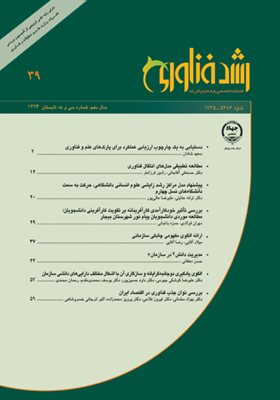بررسي توان جذب فناوري در اقتصاد ايران
محورهای موضوعی : انتقال فناوري و تجاريسازي پژوهشبهزاد سلمانی 1 * , فیروز فلاحی 2 , پرویز محمدزاده 3 , اکبر انرجاني خسروشاهي 4
1 - دانشگاه تبریز
2 - -
3 - -
4 - -
کلید واژه: جذب فناوری, بهرهوری کل عوامل, تحقیق و توسعه, سرمایه انساني, اقتصاد.,
چکیده مقاله :
امروزه اين طور بيان ميشود كه صرفاً تكيه بر سرمايه فيزيكي و نيروي كار به عنوان منابع اصلي رشد اقتصادي، باعث ميشود كشور در روند توسعه پايدار نسبت به ساير كشورها عقبتر حركت كند. بهبود بهرهوری از طریق پیشرفتهای فناوری تنها راهی است که تضمین تداوم رشد اقتصادی را به دنبال دارد. بنابراين، مطالعه بالقوه اقتصاد از نوآوريهاي فناورانه و ظرفيت جذب فناوري به منظور تخصيص منابع كمياب مؤثر و مهم است. در اين راستا هدف اصلی این مطالعه بررسی توانایی جذب فناوری خارجی در اقتصاد ایران میباشد. برای این منظور، فرضیه قدرت جذب فناوری تیکسیرا و فورتونا (2010) با دادههای آماری ایران در طی دوره 1347 تا 1390 آزمون شد. بر اساس این نظریه، وجود سرمایه انسانی مناسب باعث میشود تا فناوری ناشی از سرمایهگذاری مستقیم خارجی، واردات کالاهای سرمایهای و قراردادهای همکاری بین کشورها بیشتر و بهتر جذب اقتصاد شود. ضمناً هرچه بخش تحقیق و توسعه قویتر باشد، این جذب بیشتر خواهد بود. نتایج حاصل از تخمین مدل به روش همجمعی جوهانسن و جوسیلیوس حاکی از مثبت و معنیدار بودن امکان جذب فناوریهای خارجی به واسطه وجود سرمایه انسانی مناسب در ایران میباشد. در حالی که امکان جذب فناوری از کانال تحقیق و توسعه معنادار نبوده و تأثير معناداری بر سطح فناوری در ایران نمیتواند داشته باشد. در مجموع اقتصاد ایران به طور عمده توانایی جذب فناوری از طرف سه مؤلفه مهم جذب را دارا میباشد.
It is widely acknowledged that relying solely on physical capital and labor as main sources of the economic growth would cause countries to lag behind others in the process of sustainable development, and the productivity improvement through technological advancements is the only way that ensures the continued economic growth. So, it is important to study the economy’s potential of technological innovations and capacity of technology absorption in order to allocate the scarce recourses efficiently. Therefore, the main objective of this study is to investigate the capacity of technology absorption in the Iranian Economy. To that end, using data from the Iranian economy over the period 1347-1390, the technological absorption capability hypothesis of Teixeira and Fortuna (2010) has been tested. According to this hypothesis, the existence of adequate human capital could help the economy to absorb the technological spillovers caused by FDI, importing capital goods, and the collaborations between countries. Furthermore, this hypothesis states that the higher is the R&D expenditures, the higher is the technological absorption capability. Using the co-integration method of Johansen and Juselius (1990), it is found that the existence of adequate human capital in Iran has enhanced the technological absorption capability of the Iranian economy. However, the R&D expenditures have no significant effect on the absorption capability of the Iranian economy. In sum, the Iranian economy can benefit from the technological spillovers because of its capabilities to absorb the new technologies.

